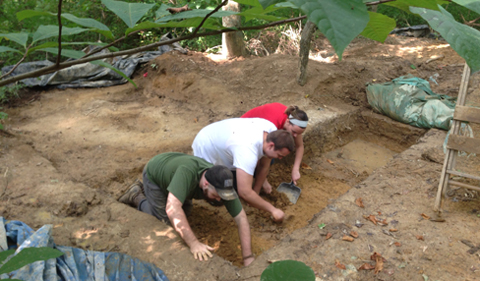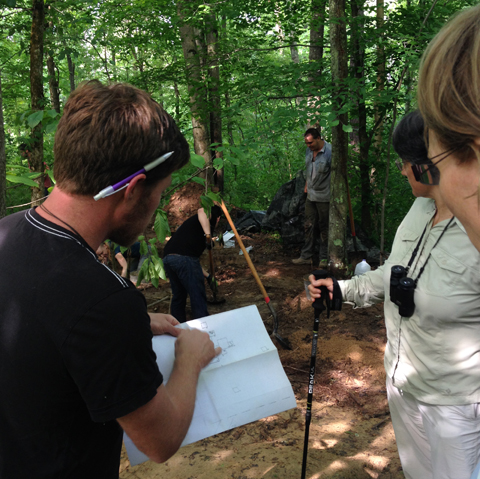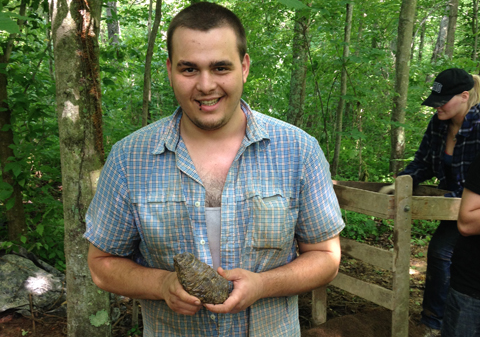
Sarah Hinkelman and Keeleigh Davis are in the foreground; Cameron Fortin is standing in the center with a shovel.
By Lori Bauer
College of Arts & Sciences
At what may be the oldest home site uncovered in Southeastern Ohio, people who lived about 4,000 years ago were mostly hunters and gatherers.
But they built a home site not far from Athens and stayed awhile.
Students archaeologists spent this summer at a dig in Wayne National Forest, and Ohio University will be returning for the next five years to help excavate the story of the Hocking Valley’s past inhabitants.
Oldest Habitation Site Ever Excavated in Hocking Valley?
“An archaeological dig site undertaken by Ohio University’s Archaeological Field School this summer in the Wayne National Forest near Nelsonville has turned up artifacts that date the human habitation of the site back to about 4,000 years ago, and possibly older,” reports the Athens News on Aug. 6.
“At the dig site Tuesday morning, students sifted through clay-red soil with screens, and carefully scraped away layers of dirt from the excavated forest floor. Paul Patton, visiting professor of anthropology at OU and director of the OU Archaeological Field School, said at the dig site Tuesday that the 4000-level class finishes this week, but that the findings from the excavation site could potentially resonate for years to come,” writes reporter Conor Morris in Dig this: Archaeology class explores 4,000-year-old culture.
“We have two radiometric dates at this point that have provided us with dates of over 4000 years BP (before present),” Patton told Morris. “Which really sets it (the site) to my knowledge as the oldest habitation site ever excavated in the Hocking River Valley, and perhaps even southeastern Ohio in general.”
Food Studies Gets Involved
In addition to the structural traces of habitation, the students also are digging up clues to what allowed the hunters and gatherers to settle for a while—possibly even a stable food source.
While the early Americans—too early to be called Adena and Hopewell—hunted game and gathered nuts, Patton and the students have collected material to analyze what appears to be evidence of plant cultivation.
“This year’s site appears to date to the Late Archaic Period, approximately 4,000 to 3,000 years ago. Already we are recovering dietary data indicating the people living at the site were harvesting black walnuts, butternuts, and hickory nuts for processing and consumption,” Patton says.
“We’ve accepted a model that argues that these people were foraging hunters and gatherers who were highly mobile,” he said (to the News).
“However, he said, there have been a number of finds that challenge that model. Paleobotanicals sent to the lab have yet to be radiocarbon dated, but Patton cited evidence of the people cultivating sumpweed, a native plant. If true, that would mean that the settlement was far more permanent, and if the botanical evidence is dated at around the 4,000-year mark or earlier, it could be rare evidence of early sophisticated cultivation techniques.
“Given our focus on understanding the transition from foraging to food production, the course is a great hands-on opportunity for students interested in Food Studies and the evolution of human diet,” says Theresa Moran, English Lecturer and Food Studies theme faculty leader.
“It is amazing to learn from Paul and his students about the daily lives of people who lived here thousands of years ago. In Ohio, we are familiar with burial mounds, but these students are uncovering how early people lived—how they fed themselves, what they ate, their implements for gathering, cooking and preparing food. Getting our hands really dirty down in the Wayne Forest clay carefully scraping away millennium with the students was a terrific experience!”
At the dig along with Moran were: Dr. David Bell, Associate Professor of Linguistics; Dr. Janet Duerr, Associate Professor of Biological Sciences; and Anne Chelboun, Food Studies intern.
An Archaeology Team of 17 Undergrads
Seventeen students took part in Field School in Ohio Archaeology led by Patton, who is also an alum and a Visiting Assistant Professor at Ohio University .
“The field school provides students with the skills necessary to pursue graduate-level research, a career in cultural resource management, or just broader understanding about how archaeologists obtain data,” Patton says. “By the nature of the course, the field school allows students to apply information they have obtained in a traditional classroom setting to actual data collection in the field while excavating a prehistoric native American site.”
The archeology research focuses on habitation sites where students can obtain data to better understand the day to day lives of people who lived thousands of years ago.
“Particularly, we excavate sites during the critical transition from hunting and gathering to plant domestication here in the Hocking Valley,” Patton says.
The Field School in Ohio Archaeology, established in 1986, has produced a very rich data base on the pre-conquest societies of southeastern Ohio. The research focus has been, and continues to be, excavation of habitation sites rather than burial mounds since it is the living areas where data relating to the domestic life of these past communities will be recovered.























Comments